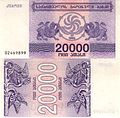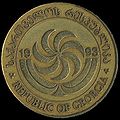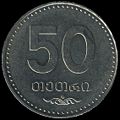Top Qs
Timeline
Chat
Perspective
Georgian lari
Currency of Georgia From Wikipedia, the free encyclopedia
Remove ads
The lari (Georgian: ლარი, pronounced [ˈɫaɾi]; ISO 4217: GEL) is the currency of Georgia. It is divided into 100 tetri (თეთრი). The name lari is an old Georgian word denoting a hoard, property, while tetri is an old Georgian monetary term (meaning 'white') used in ancient Colchis from the 6th century BC. Earlier Georgian currencies include the maneti (Georgian: მანეთი), abazi (აბაზი), and kuponi (კუპონი).
Remove ads
Kuponi
Georgia replaced the Soviet ruble on 5 April 1993, with the kuponi (Georgian: კუპონი) at par. This currency consisted only of banknotes, had no subdivisions and suffered from hyperinflation. Notes were issued in denominations between 1 and 1 million kuponi, including the somewhat unusual 3, 3,000, 30,000 and 150,000 kuponi.
- Highest denominations of each series of the Georgian kuponi
- 10 000 kuponi, 1993 (1st issue)
- 100 kuponi, 1993 (2nd issue)
- 100 000 kuponi, 1993 (3rd issue)
- 20 000 kuponi, 1994 (4th issue)
- 1 000 000 kuponi, 1994
Remove ads
Lari
Summarize
Perspective
On 2 October 1995,[2] the government of Eduard Shevardnadze replaced the provisional coupon currency with the Lari, at a rate of one million to one. It has remained fairly stable since then.
Lari sign

The NBG announced the Lari sign competition in December 2013. The temporary commission consisted of representatives of NBG, the Budget and Finance Committee of the Parliament of Georgia, the State Council of Heraldry, the Ministry of Culture and Monument Protection of Georgia and the Ministry of Education and Science of Georgia.[3]
On 8 July 2014, Giorgi Kadagidze, Governor of the National Bank of Georgia (NBG), unveiled the winning proposal for the sign of the national currency to the public.[4] The author of the winning sign was professional artist-ceramist, Malkhaz Shvelidze.[3]
In choosing the winning sign, the commission gave priority to the samples based on the Georgian Mkhedruli character and made a point of the following criteria: conception, design, accordance with Georgian alphabet, existence of elements marking the currency, ease of construction, and observance of requests and recommendations determined by competition rules.[3]
The Lari sign is based on an arched letter ლ (Lasi) of the Georgian script. It is common international practice for a currency sign to consist of a letter, crossed by one or two parallel lines. Two parallel lines crossing the letter Lasi are the basic components of the Lari sign. The so-called “leg” of the letter, represented by a horizontal line, is a necessary attribute of the sign, adding monumental stability to the upper dynamic arc. The form of the letter is transformed in order to simplify its perception and implementation as a Lari sign.[3]
On 18 July 2014, Giorgi Melashvili, executive director of the National Bank of Georgia, sent a request letter to the Unicode Consortium to register the symbol in the Currency Symbols block of the Unicode Standard as
- ₾
U+20BE GEORGIAN LARI SIGN[5]
On 17 June 2015, the Unicode Consortium released[6] Unicode V8.0, which includes the Lari sign as
- U+20BE ₾ LARI SIGN[7]
Coins
Coins are issued in denominations of 5, 10, 20 and 50 tetri, as well as 1 and 2 lari.
The National Bank of Georgia announced on 5 October 2018 that it would discontinue circulation of 1 and 2 Tetri coins as of 1 January 2021, and that these coins would lose their legal tender status. 1 and 2 Tetri coins could be exchanged at the National Bank of Georgia and commercial banks in Georgia within one year from 1 January 2021, and can only be exchanged at the National Bank of Georgia from 1 January 2022.[8][9] According to the new regulations on cash payments introduced by the National Bank of Georgia on 1 January 2019, 1 and 2 tetri are rounded to 0, and 3, 4, 6 and 7 tetri are rounded to 5[clarification needed].[10]
The National Bank of Georgia announced on 12 November 2015 that, effective 1 January 2018, the old 50 Tetri coin, issued since 1995, would be withdrawn from circulation and the coins would lose their legal tender status. The old 50 Tetri coin were exchangeable at the National Bank of Georgia and commercial banks of Georgia within one year from 1 January 2018, and from 1 January 2019 only at the National Bank of Georgia.[11][12][13]
Banknotes
Current series
Between November 2016 and October 2019 the National Bank of Georgia released five banknotes (in denominations of ₾5, ₾10, ₾20, ₾50, and ₾100), composing a new complete set.[14] The 2016–2019 series lari notes were produced in collaboration with Oberthur Technologies, Giesecke+Devrient and De La Rue.
Earlier issues
The National Bank of Georgia announced that banknotes of 1, 2, 5, 10, 20, 50 and 100 lari issued between 1995 and 1999 will no longer be legal tender on 1 January 2022. These currencies can only be exchanged at the National Bank of Georgia from 1 January 2022.[15][16]
| Preceded by: Georgian kupon lari Reason: Replacement of the Soviet and Russian ruble with a transitional currency |
Currency of Georgia April 5, 1993 – October 2, 1995 |
Succeeded by: Georgian lari Reason: Hyperinflation Ratio: 1 Georgian lari = 1,000,000 Georgian kuponi |
| Preceded by: Georgian kuponi lari Reason: Hyperinflation Ratio: 1 Georgian lari = 1,000,000 Georgian kuponi lari |
Currency of Georgia October 2, 1995 – |
Succeeded by: Current |
Remove ads
See also
References
External links
Wikiwand - on
Seamless Wikipedia browsing. On steroids.
Remove ads





















